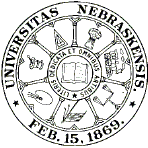
University Studies (University of Nebraska) (1888–1984)
Date of this Version
1965
Citation
University of Nebraska Studies : New Series no. 30
Abstract
The Goajira Peninsula forms the northernmost extension of continental South America (see Fig. 1). Its lobate outer portion, the area of this geologic study, is a mountainous region about 75 kilometers wide at its widest part and juts 150 kilometers northeastward into the Caribbean Sea. Although only about 110 kilometers north of the city of Maracaibo, Venezuela, the Peninsula is isolated and little known. Only a narrow coastal strip lies in Venezuela; the remainder is in Colombia; but the Peninsula is largely a desert wasteland not extensively entered by people other than its own sparse Indian population. Its remoteness has long led it to be called the "Forgotten Land of Colombia." The exposures of Mesozoic and Cenozoic rocks on the Peninsula present a seldom equalled opportunity for fundamental study in stratigraphy, structure, and sedimentation. Probably few places in all of northern South America present a comparable area for the study of Cretaceous limestone lithology and deposition. Because of the arid nature of the region, the rocks are well exposed in most areas. As a result the outcrops can be studied in detail and lateral changes can be observed instead of surmised. The sedimentary, metamorphic, and igneous rocks found in the Goajira indicate a long and varied geologic record. The sedimentary section is made up of a thick sequence of Mesozoic and Cenozoic strata. Of particular interest from a regional viewpoint is the succession of Cretaceous limestones, shales, and sandstones. In addition, structural deformation of a complex nature clearly demonstrates some of the basic phenomena of the compressive deformation of rocks. On the southeastern part of the Peninsula compressive stresses have buckled the sediments of the Cocinas trough into an asymmetrically overturned and severely faulted anticlinal structure. Farther northward, the Serranias Jarara and Macuire have been uplifted into their present position after a much earlier period of severe crumpling. Metamorphism and igneous activity of several periods have further complicated the geology.
The five primary objectives of this research project were: (1) to study in detail the stratigraphic succession of both the Mesozoic and Cenozoic rocks, with special attention to the Cretaceous limestone sequence; (2) to correlate the formations of the Goajira with the stratigraphic succession elsewhere in western Venezuela; (3) to propose an areal synthesis of the orderly sequence of geologic events which occurred on the Goajira as interpreted from the field data; and (4) to reconcile and integrate observations made on aerial photographs with those made in the field.
85x52 cm @ 800dpi
map whole.tif (55806 kB)
The same as bitmap 55 MB
Figures B-1--17.pdf (4296 kB)
All 17 figures
Figure B-1.tif (12679 kB)
Figure B-2.tif (12677 kB)
Figure B-3.tif (12679 kB)
Figure B-4.tif (12680 kB)
Figure B-5.tif (12680 kB)
Figure B-6.tif (12680 kB)
Figure B-7.tif (12347 kB)
Figure B-8.tif (12679 kB)
Figure B-9.tif (12679 kB)
Figure B-10.tif (12680 kB)
Figure B-11.tif (12679 kB)
Figure B-12.tif (12680 kB)
Figure B-13.tif (12678 kB)
Figure B-14.tif (12680 kB)
Figure B-15.tif (12679 kB)
Figure B-16.tif (12680 kB)
Figure B-17.tif (12679 kB)
Map upper left 050.tif (25549 kB)
@ 1000 ppi
Map upper right051.tif (25149 kB)
@ 1000 ppi
Map lower right 052.tif (25284 kB)
@ 1000 ppi
Map lower left 053.tif (25161 kB)
@ 1000 ppi


Comments
published by the university at lincoln : march 1965
Map of peninsula (pdf & tif) and Figures B-1 through B-17 are attached below.